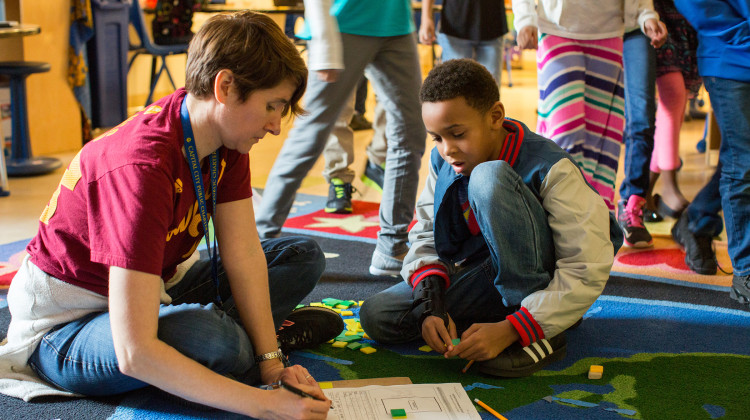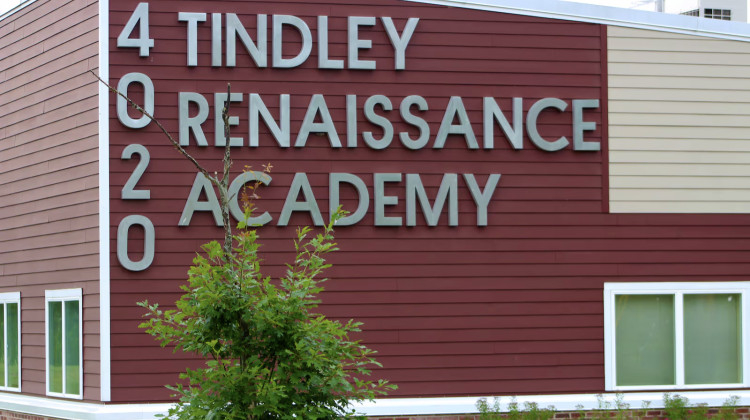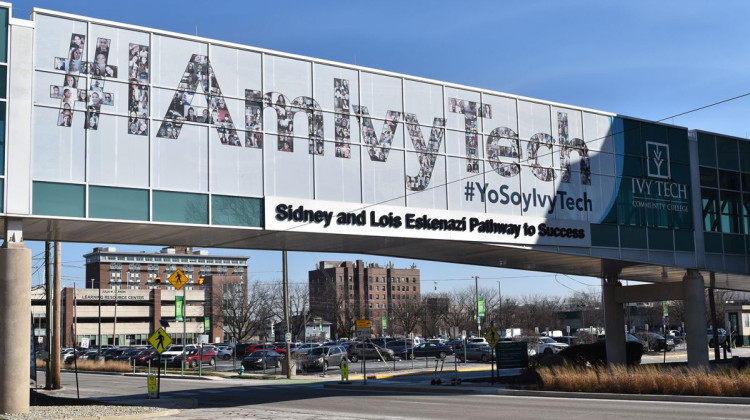
The IN Region 4 Migrant Preschool Center, a free preschool for migrant children ages 2 to 5, teaches students in English and Spanish. The goal is to prepare migrant children for school, wherever it may be.
Peter Balonon-Rosen/IPBSDepending on the season, Indiana farms employ between 2,000 and 20,000 migrant farm workers. When workers migrate, often their families do, too.
Children in this mobile lifestyle can face interrupted schooling, cultural and language barriers, and social isolation — factors that inhibit a child’s ability to do well in school.
A public preschool for migrant children in Vincennes, the IN Region 4 Migrant Preschool Center, works to combat that. The preschool teaches migrant children, ages 2 to 5, in English and Spanish. It aims to prepare them for future instruction, wherever they may go.
“We like to do all the basic preschool things with math skills, language skills, letters, numbers,” says Debbie Gries, migrant education coordinator for the Region 4 Indiana Migrant Regional Center. “But our end goal, when they’re five, is to have them ready for kindergarten.”
Step One: Pick Up Students
The sun hasn’t risen, but 4-year-old Ximena is full of energy.
It’s Monday, 6 a.m..
Clad in a pink hoodie, Ximena sprints back and forth in the trailer her mother, Anayeli Camacho, rents on farmland in Oaktown, Indiana.
Camacho is a member of a largely invisible population: the thousands of migrant farmworkers that plant, cultivate, pick and pack fruits, vegetables and nuts in Indiana each year. For a decade, Camacho has migrated between farms in Florida and Indiana, following work. Right now, she works picking pumpkins.
At 6:30 a.m., a knock.
Ximena’s bus to preschool sits rumbling, in the dark, on the gravel road outside. On board, a teacher buckles Ximena into a carseat.
Soon, almost all of the children fall asleep. Makes sense. It’s Monday. It’s an hour to and from the other farms on the way to the preschool. And it’s still dark.
“We run our morning route really early because most of the prime work season for the parents, they are starting when it’s light outside,” says Gries, the migrant education coordinator for southwestern Indiana’s migrant regional center.
The state- and federally-funded center provides free preschool to migrant children, like Ximena. To qualify as a migrant child, at least one parent has moved to Indiana in the past three years for an agricultural job. During the spring and fall, the center serves about 30 children who come to Indiana from Georgia, Florida or Texas.
“Because their parents move around a lot, they don’t have the stability of being in one location for very long where they might be able to take advantage of other preschool services,” Gries says.
And many families can’t move with many items that help children learn, like books, toys and balls.
Step Two: Songs and Lessons in Spanish and English
So when Ximena and classmates get to preschool, just as the sun rises, this isn’t just childcare. The focus is learning.
That’s largely teaching students English, but staff also incorporate and honor the Spanish many children speak at home.
“We try to help the children learn words in both languages,” Gries says.
So teachers lead children in songs full of English vocabulary – like the animals and body parts. The children dance. They jump up and down, hooting and hollering, reciting songs.
And then there’s math.
“One, two, three, four, five!” Ximena says, excitedly. “Uno, dos, tres, quatro, cinco!”
Learning to count: a math lesson for preschoolers.
And there’s preschool geometry, too.
“What shape is this?” asks Sarah Ross. The preschool teacher reaches into a bin of bright yellow, red and blue shapes. She pulls one out.
“Circle!” the group of children yells back.
Migrant education coordinator Gries says these activities serve a dual purpose.
“[It's] also trying to get them to talk as much as they can, just to keep their language skills growing,” Gries says.
The children also learn non-academic skills.
Outside, in the preschool’s lush green yard, children practice dribbling a soccer ball. It’s fun – but it’s also a lesson in body control, motor skills and hand-eye coordination.
For Migrant Families, Barriers to School Services
A major barrier for young migrant children to get to preschool and learn these skills, is, well, timing. Families move with planting and harvest schedules, not the school year.
“Many times they arrive after a preschool semester has started,” says Ray Melecio, assistant director for ESCORT, a Florida-based technical assistance center for migrant education programs.
Many migrant workers start the year in states like Florida and Texas. Then, when it’s spring or summer, they travel north to states like Indiana.
“Staff go into fields trying to find and talk to these families and see if they want to enroll their kids in the program,” Melecio says. “Sometimes these families might not be found. And sometimes, these families don’t want to be found.”
Step Three: Storytime, Then Back Home
Back at the preschool, teacher Mirna Sandoval reads students the Lion King in Spanish. El Rey León.
It helps the young students learn new Spanish vocabulary. And, judging by the laughter erupting from the crowd, it’s also a blast.
As Sandoval and students repeat “hakuna matata” back and forth in singsong voices, the children can’t contain fits of laughter.
Soon, the school day ends. Children pile back onto the bus. Once again, teachers buckle them into carseats. Now, heading the opposite direction from this morning.
As the bus speeds past the fields where many parents work, children sing “The Wheels on the Bus Go Round and Round.” Soon, a verse about piggies who go “oink, oink, oink.”
Teacher Christine Vaughn pauses.
“Wait a minute, why is there a piggy on our bus?” Vaughn asks.
Five-year-old Kleanni, doesn’t hesitate.
“‘Cause it has to go to school!” Kleanni says.
 DONATE
DONATE














 Support WFYI. We can't do it without you.
Support WFYI. We can't do it without you.